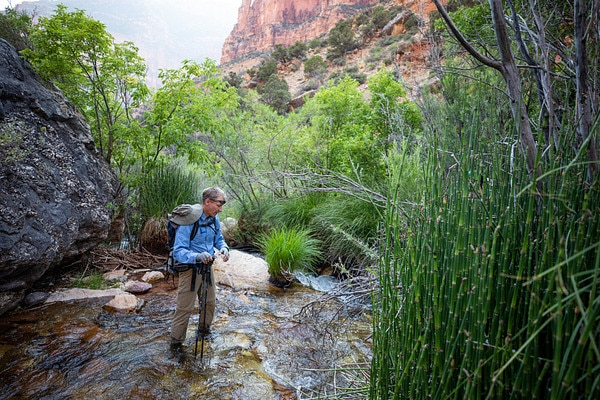*Editor’s Note: The “Views from NAU” blog series highlights the thoughts of different people affiliated with NAU, including faculty members sharing opinions or research in their areas of expertise. The views expressed reflect the authors’ own personal perspectives.
World Water Day is an annual United Nations observance day held on March 22. The day highlights the importance of freshwater and the need for sustainable management of freshwater resources—a pressing issue for all. Abe Springer, professor of ecohydrogeology in the School of Earth and Sustainability, shared his expertise with The NAU Review, giving insights on the critical importance of sustainable freshwater management and why it is essential to ensure a healthy future for our planet.
 By Abe Springer
By Abe Springer
Professor of ecohydrogeology, School of Earth and Sustainability
On World Water Day, celebrated globally on March 22, we could all benefit from placing our regional and local water issues in the context of global water issues. One of the best global summaries of the state of water resources has been developed by the United Nations. The UN has developed 17 sustainable development goals related to the themes of water, energy, climate, oceans, urbanization, transport and science and technology. Sustainable Development Goal No. 6 is to ensure the availability and sustainable management of water and sanitation for all. The 2023 UN report on the progress of the goals related to water and its associated ecosystems indicates that much work still needs to be done.
- Over the past 300 years, more than 85 percent of the planet’s wetlands have been lost.
- Meeting drinking water, sanitation and hygiene targets by 2030 require a four-times increase in the pace of progress of the goals.
- At current rates of goal progress, in 2030:
- 1.6 billion people will lack safely managed drinking water.
- 2.8 billion people will lack safely managed sanitation.
- 1.9 billion people will lack basic hygiene facilities.
- For at least 3 billion people, the water quality they depend on is unknown due to a lack of monitoring.
- More than 730 million people live in countries with high and critical levels of water stress.
Goal 6.6 focuses on water’s role in protecting and restoring the earth’s natural world, particularly water-related ecosystems. The goal states: “By 2020, protect and restore water-related ecosystems, including mountains, forests, wetlands, rivers, aquifers and lakes.” While the official wording of target 6.6 states 2020, it is assumed by the UN Environmental Programme that the date will be updated to 2030.
Research done by the ecohydrogeology group at NAU in conjunction with the Springs Stewardship Institute is focused on science, management, conservation, restoration and policy for springs ecosystems. Springs exist at the interface between surface water and ground water, complicating their legal, management and policy status. Springs are abundant, discrete, biologically diverse and often highly productive ecosystems, particularly in Arizona’s arid to semi-arid regions and the adjoining Colorado Plateau. We have been able to document and predict trends in climate, human pumping of aquifers, and the alterations of the landscape processes recharging aquifers to help guide the stewardship of these hotspots of biological diversity.
Arizonans use about 7 million acre-feet of water per year. Of this supply, 41 percent is from groundwater, 36 percent is from the Colorado River, 18 percent is from rivers within the state and 5 percent is reclaimed water. Most of the water flowing in rivers within the state is derived from discharge from aquifers through springs. Most of the water in the state (72 percent) is used for agriculture, while 22 percent is for municipal use and 6 percent is for industrial use. Over the past 40 years, the state has continually used less water due to conservation and other practices as the population has significantly increased. An important component of these water solutions is better and more innovative management practices for reclaimed water. These uses vary from making snow, aquifer recharge or direct potable reuse.
Arizonans have a stable and secure water supply. The state has groundwater management districts in the major metro areas and some of the agricultural areas. These Active Management Area districts are required to demonstrate the availability of a 100-year supply of water. Although Flagstaff and Coconino County are not in one of these management districts, the City of Flagstaff uses similar guiding principles for management. These principles include policies, economic incentives, technology and conservation practices. We all benefit from assessing the sustainability of our water availability relative to the UN’s sustainable development goals. The increase in the extremes of dry and wet climates will require continued innovation. Join me in sharing a toast of fresh, clean drinking water on this World Water Day.




